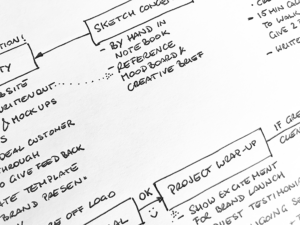GREAT APPS AREN’T JUST BUILT, THEY’RE TRUSTED.
Quality assurance isn’t a checkbox at the end of development. It’s a strategic lever that protects your roadmap, your budget, and your brand reputation. At Ronins, we’ve seen how overlooked QA costs more than teams expect—weeks of rework, frustrated users, delayed launches. But when QA is treated as a first-class citizen from day one, it speeds everything up.
We challenge assumptions, simulate edge-case chaos, and bring in fresh eyes where dev teams are too close to the code. The result? Fewer bugs in production, faster feedback loops, and confidence that your app can thrive in the real world—across devices, OS versions, and user behaviours. QA done right doesn’t just find problems. It prevents them.
THE ROLE OF QA
Beyond the Bug List: Why Strategic QA Protects Products at Scale
Quality Assurance in mobile apps isn’t just a safeguard—it’s a multiplier. Done well, QA prevents reputational risk, reduces rework, and enables rapid scaling across platforms and devices. In this section, we unpack how Ronins approaches QA not as a final hurdle, but as a foundational layer in mobile product strategy.

What We Write About
Real-world QA challenges: We go beyond theory and templates to explore the overlooked issues that derail mobile apps—from flaky test environments to false positives and device fragmentation.
Agile QA practices: We write about integrating QA into fast-paced, iterative teams without slowing them down. Think shift-left strategies, automated regression suites, and testing as a growth enabler.
Testing for scale: Our content covers what matters when your app starts to scale—concurrent users, edge cases, load balancing, and multi-device reliability across OS versions.
Tools and techniques that work: From exploratory testing to CI pipelines and test coverage analytics, we break down the approaches that actually move the needle in real shipping apps.
Invisible quality signals: We explore how to design QA processes that reduce friction, protect UX, and deliver products users trust—even if they never notice the testing behind it.

Who We Write It For
Founders and product leads: You want your app to work first time, every time. We help you understand how QA protects your roadmap, your brand, and your user retention.
Engineering leaders: You need scalable, efficient QA workflows that won’t block delivery. We share strategies, tooling options, and team models that support fast-paced agile builds.
Investors and advisors: You’re backing mobile-first ventures. Our insights help you evaluate risk, readiness, and the technical diligence behind a product’s polish.
QA specialists and testers: You’re already in the weeds. We go deeper—sharing hard-won insights from live projects, emerging standards, and edge-case learnings you won’t find on Reddit.
Anyone scaling a mobile app: Whether you’re launching or maturing, our content gives you the clarity, benchmarks, and practical ideas to level up your QA and product quality.

Questions We Get About Mobile App QA
When should QA start in an agile project?
QA should start from day one, ideally during discovery. Early involvement helps shape user stories, identify edge cases, and reduce rework later. Waiting until the build phase often results in missed defects, misaligned priorities, and costly last-minute fixes. Continuous QA embedded in sprints ensures faster feedback loops, better coverage, and a smoother release cycle, especially in high-pressure mobile environments where bugs cost both trust and traction.
How much testing is enough for launch day?
“Enough” depends on your risk appetite, user volume, and tech complexity, but our rule of thumb is this: if you haven’t tested edge cases, failure states, and concurrency under real-world conditions, it’s not ready. Your QA effort should include unit tests, UI tests, integration testing, device coverage, and regression checks. We help define an MVP-appropriate app QA strategy that balances speed with confidence.
What tools do you use for mobile QA?
We tailor tooling to each client’s stack and scale. Typically, we combine tools like BrowserStack or Firebase Test Lab for device coverage, with CI integrations like GitHub Actions or Bitrise. For test management, we often use TestRail, and for automation, Appium or Detox depending on tech. But tools don’t solve problems alone, our QA process combines smart automation with human exploratory testing that catches what scripts miss.
Can you test across all mobile devices?
Not all devices, but the ones that matter. We focus on coverage, not volume. That means testing across key OS versions (iOS/Android), screen sizes, manufacturers, and connection conditions. We use emulators, cloud test farms, and physical devices to balance speed and realism. Device prioritisation is guided by your user data, because testing 200 phones doesn’t help if 80% of your users are on ten.
What’s the ROI of investing in QA early?
Early QA drastically reduces costly rework, improves user retention, and protects your app’s reputation. Bugs caught in discovery or sprint testing are up to 10x cheaper to fix than in production. It also shortens future sprints by improving developer velocity. More importantly, it builds user trust—your app behaves as promised, under load and at scale. That’s the kind of performance investors and users notice.
How do you approach performance testing?
We design realistic test scenarios that simulate spikes in usage, background app switching, memory stress, and network drops. Performance testing isn’t just about speed, it’s about graceful degradation. Can your app recover from slow 4G? What happens if location services lag? We test all that. Our QA process includes load testing, profiling, and heatmaps to highlight where performance bottlenecks live, before your users feel them.
an QA help improve app store ratings?
Yes, consistently. Poor ratings often come from bugs, crashes, or broken UX flows. Robust QA catches those before release. But it also helps smooth onboarding, fix unexpected behaviour, and ensure updates don’t break existing features. We track crash analytics post-launch and rapidly test hotfixes before shipping. When users don’t hit friction, they’re more likely to rate, and recommend. QA isn’t just defensive; it supports growth.
Do you support testing after app launch?
Absolutely. We provide regression testing, release candidate validation, and ongoing QA support during post-launch feature cycles. We also offer monitoring and crash log triage, so you’re not blind after updates. QA doesn’t end when v1 goes live, it evolves. Continuous testing helps reduce churn, protect uptime, and respond faster to user-reported issues. Our clients see this as part of product lifecycle success, not a one-off.
What does automated testing actually cover?
Automated tests are great for catching regressions, validating known paths, and speeding up releases—but they don’t replace manual QA. We automate where it counts: core flows, API responses, login/authentication, and smoke tests. But edge cases, usability quirks, and accessibility need human input. Our approach blends automation and exploratory testing to give you fast confidence without blind spots. It’s not either or it’s smart balance.
How do you handle cross-team collaboration?
We embed with your dev team from the start, either directly in your sprint rituals or through structured async QA workflows. We speak product, design, and dev fluently, which helps translate defects into action and ensure fast triage. We also log, tag, and prioritise issues clearly in whatever tool you use, Jira, Linear, Notion, or others. Great QA isn’t isolated. It’s integrated, visible, and reliable.





